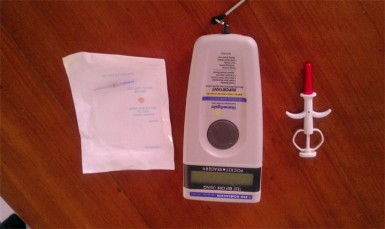Guyanese pet owners have the ability to electronically track their lost animals using microchip technology, being made available by Pets 2000 animal clinic, says Dr Nicholas Waldron, veterinary specialist of the clinic.
The radio frequency identification chip has been offered by the clinic since 2010 after animal tracking and European Union member countries started to use it as a requirement for air travel, Waldron told Stabroek News in an interview.
He said that the chip is a tiny device that is inserted under the skin of the animal without side effects. “The most they will feel is the prick

when the chip is being inserted,” he added. Pets 2000 is the first animal clinic to offer such a service.
The chip, he said, is able to track animals because it has an identification number electronically embedded in it, and it is almost “foolproof.”
Waldron said that the device is a modern replacement for a dog collar and is more reliable since it is not identifiable on the body of the animal. The chip, which is the size of a rice grain, is easily lost under the skin but only detected by a microchip radar. “If the animal is lost or there is a dispute of the ownership of an animal then the radar would be able to read the number on the chip and if it’s the same number as the animal that was registered then it is the right animal,” Waldron explained.

He said that the chip is inserted in a syringe identical to Hypodermic syringe and is then inserted under the skin of the animal. The animal would have its own identification number, much like a human identification card.
“It’s just like a collar with a name and it’s much more reliable, apart from that it is becoming a requirement for international travel because of all the issue they have with diseases when travelling from countries to countries,” he stated.
“A collar could get lost… it could get chewed up or it could be taken off but the microchip is embedded,” he emphasized, noting that a microchip can be embedded in all almost all species of animal.
The cost for the insertion of the chip is $10,000 and it is embedded in the animal for its lifespan. Pets 2000 is located at Lot 307 Stone Avenue, Campbellville.





